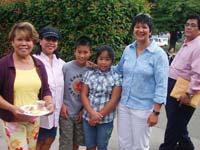Patriotism and Pinoy Pride

By Mable Elmore
MLA British Columbia
“My realization of Philippine Independence Day came quite late in life. As a second-generation Filipino-Canadian born to a Cebuana mother and an Irish-Canadian father, we never celebrated this historic day. I never learned about it in school and I certainly didn’t see it in the news.
It was only after doing some personal reading when I was in my 20s that I found out June 12th is Philippine Independence Day. I hope that as we mark this day with various celebrations across BC, we also take the time to reflect on its meaning.
For myself, Philippine Independence Day is about the fighting spirit of the Filipino people for national sovereignty and freedom. It’s about the sacrifices that countless martyrs made when they participated in revolts and revolutions against their Spanish and then American colonial masters. It’s about the strong patriotism and Pinoy pride that many Filipinos embody wherever in the world they may be.
As well, this day is a time to honour the country’s revolutionary martyrs.
Our independence from Spain was possible after a succession of revolts led by the KKK or (Kataas-taasan, Kagalang-galangang Katipunan ng̃ mg̃á Anak ng̃ Bayan in Tagalog) and others across the archipelago. Their sacrifices made possible the Declaration of Independence that was written and read by Ambrosio Rianzares Bautista or Don Bosyong on June 12, 1898 in Kawit, Cavite. In front of a large crowd that had gathered in front of the ancestral home of General Emilio Aguinaldo, our independence from Spain after 325 years of colonial rule was proclaimed in Spanish and the Filipino flag (that was made in Hong Kong by Marcela Agoncillo, Lorenza Agoncillo, and Delfina Herboza) was unfurled for the first time. The new nation’s national anthem, Lupang Hinirang, composed by Julian Felipe was also played.
However I have to mention that this “independence” was short-lived because it was not recognized by the Spaniards or the Americans.
Shortly after the declaration of independence, Spain sold the Philippines to the Americans for $20 million through the Treaty of Paris on April 11, 1899. So after more than 300 years of Spanish rule, the Americans became the country’s next colonial master and the little talked about Filipino-American war began.
The war lasted from 1899 to 1902 and some estimates say 10% of the Filipino population at the time or 600,000 Filipinos were killed while 70,000 soldiers died. This was a brutal and bloody war where American soldiers were ordered to shoot at every Filipino over the age of 10 years old.
After more than four decades of rule, the Americans finally recognized Philippine Independence on July 4, 1946 in the Treaty of Manila. Subsequently, Philippine Independence Day was observed on July 4th until then President Diosdado Macapagal declared June 12th as the country’s Indpendence Day.
Today, I believe that many lessons of Philippine Independence both from the Philippines and the US remain relevant and important. I encourage all Filipinos, especially the younger generation to read about them. I know that for myself, learning about our past and finding out about our heroes bolstered my sense of pride and confidence to speak and organize around various social issues.
Our capacity to organize, mobilize and be just more vocal as a community is more important than ever.
In our homeland, many challenges for the Filipino people remain. Worsening poverty, rising human rights violations and the increasing number of Overseas Filipino Workers are cause for concern.
Locally, the rights and welfare or immigrants and temporary foreign workers remain vulnerable and are even worsening. The lack of an accessible pathway to permanent residency (especially for low-skilled TFWs), the non-recognition of foreign credentials, the lack of representation in leadership positions and the erosion of our social services are just some of the urgent issues that I believe need to be tackled.
So while the dancing and the food, and the fiestas and the celebrations that we organize annually are indeed important in terms of giving us an opportunity to rejoice and recall our roots, we should also anchor our sense of cultural identity in Philippine history and the legacy it has left us.
To conclude, I would also like to underline that while Philippine Independence Day is indeed just one “day”, the struggle of the Filipino people to continually maintain and assert its freedom, sovereignty and dignity is an ongoing one – that needs everyone’s participation.
As Filipinos in BC, I hope that many more of our kababayans will continue to actively participate in the many facets of life in our province so that progressive changes can be made that will result in a more equitable and just society for our families and our future generation.”
Leave a comment






